TugboatEng
Marine/Ocean
My application isn't a pump but it's similar. Propeller on my boats are distributed pitch props in nozzles. I am having an issue where the low speed load from the prop is too high. Typically to reduce load, one would re-pitch the prop but that would also reduce the high speed thrust. This is a varying pitch prop so it has more pitch towards the hub and less towards the tips. Am I wrong to think that increasing pitch towards the hub while simultaneously reducing pitch at the outer diameter would, maybe, decrease thrust at low rpm and maintain it at high rpm?

